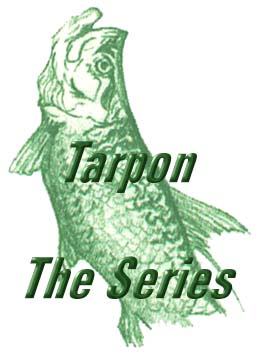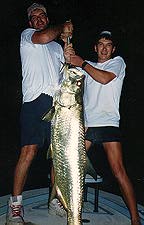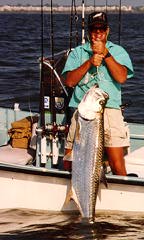

| This Florida fishing mini-series uncovers the secrets of Florida fishing guide, Capt. Robert McCue and explains the techniques actually utilized in his Tampa Bay tarpon fishing charters. Further, the mini-series discusses biology, saltwater flats, backcountry, beach, flyfishing, and light tackle information employed on our Giant tarpon fishing charters in the Tampa Bay area. Whether you are tarpon fishing guru, or have ever dreamed of catching Giant Florida tarpon, the series offers something for everyone. Please feel free to visit all parts of the series by following the links within this page. |
For a complete in depth coverage on our
Tampa Bay Fishing Charters - tarpon fishing charters please follow this link.
PART 4 0F 4
| Tarpon Fishing Part I | Tarpon Fishing Part II | Tarpon Fishing Part III |
![]()
Gin-clear flats,
white sugar sand beaches and swift flowing passes are traditional settings for those
who stalk the spectacular tarpon along Florida 's Gulf coast. From April until about
the full moon in July, rare is the dawn that doesn't find a bleary-eyed and demented
angler lurking along the well-known travel and fishing paths of the world's greatest
gamefish. The tarpon.
 Shortly after that full moon in July,
the tarpon anglers disappear faster than toilet paper during a blue-light special. Tarpon
can be found roaming the saltwater flats, beaches and passes - but the tarpon
fishing in those areas becomes very inconsistent the rest of the summer. As I've
discussed in previous installments of this series, what brings the tarpon to these
whereabouts of Florida is part of their pre-spawn ritual. The spring migration southward
of pre-spawn tarpon slowly, but surely, becomes a summer northward migration of post-spawn
tarpon. Until finally, they all but disappear.
Shortly after that full moon in July,
the tarpon anglers disappear faster than toilet paper during a blue-light special. Tarpon
can be found roaming the saltwater flats, beaches and passes - but the tarpon
fishing in those areas becomes very inconsistent the rest of the summer. As I've
discussed in previous installments of this series, what brings the tarpon to these
whereabouts of Florida is part of their pre-spawn ritual. The spring migration southward
of pre-spawn tarpon slowly, but surely, becomes a summer northward migration of post-spawn
tarpon. Until finally, they all but disappear.
Disappear? Well, not really - if you know where they went. As the post-spawn fish move
north a percentage of the fish "break off" their path of travel to enter
bays and rivers along the coast. Why they like this mixture of salt and fresh water (in
some cases completely fresh) is not totally understood and is another part of the tarpon's
mystique. One thing is certain: the temperament of these "off-season" Florida
tarpon is unlike that of their springtime counterparts and best of all...tarpon fishing
goes on. Summer tarpon are here to eat. The waters of both Charlotte Harbor, Pine Island
and Tampa Bay support great populations of these late season tarpon. Due to its close
proximity to my home, Tampa Bay is where I spend most of my fishing time.
While pre and post season giant tarpon in Tampa Bay and Charlotte Harbor are no secret, this fishery is very much over-looked. For the most part, there are no crowds. While it is true the fish move around a lot and don't roll as often, it can be some of the best fishing of the year.For those in the know...tarpon season is far from over.
It would be unjust to speak of Tampa Bay tarpon without
acknowledging Capt. Jimmy Bradley , friend and a silver king pioneer of the late 50's
and 60's.... who has shared much of his wisdom with me.
There are countless places and methods to fish for summer tarpon - far too many to
completely cover in this story. Year after year, however, the tarpon seem to keep showing
up in the same places and eating the same things. The theater may be a channel, dredge
hole, river mouth, bridge, deep flat, oyster bar, "live" hard bottom, grass
edge, points, troughs, docks or submerged rip-rap. Techniques include flyfishing,
plugging, trolling, corking with live bait, bottom fishing and drifting. Although summer
tarpon can be found in many different places, if I had to pick the type of spot most
likely to produce fish, it would definitely be bridges.
 No single spot consistently holds more
tarpon in the bay than bridges. These bridges (we have over fifty miles' worth in Tampa
Bay) are tarpon magnets during the summer. The fishing can be so reliable that my
exclusive "Guaranteed" charters are run in their shadows. Understanding how the
fish move around the bay will determine which bridges to fish. The Sunshine Skyway,
however, is a reliable hot spot all summer long. During the big tides of the full and new
moons, drifting live sardines and herring through the pilings and shadow lines cast by the
structure is a sure-fire way to get hooked up.
No single spot consistently holds more
tarpon in the bay than bridges. These bridges (we have over fifty miles' worth in Tampa
Bay) are tarpon magnets during the summer. The fishing can be so reliable that my
exclusive "Guaranteed" charters are run in their shadows. Understanding how the
fish move around the bay will determine which bridges to fish. The Sunshine Skyway,
however, is a reliable hot spot all summer long. During the big tides of the full and new
moons, drifting live sardines and herring through the pilings and shadow lines cast by the
structure is a sure-fire way to get hooked up.
On the slower quarter-moon tides, a change in tarpon fishing technique is often needed.
Setup on the up-current side of the bridge and hook up what is nothing short of a magical
tarpon bait: fresh dead menhaden. Sling the weighted bait (it should lie flat on the
bottom) into the pilings, then begin a fishing technique borrowed from northeastern tuna
fishermen -- chunking. Sweeten the area by ladling cut-up pieces of this oily bait into
the water, allowing the tide to carry the chum slick under the bridge. The aroma dribbles
around the pilings, producing much the same effect on tarpon as a picnic basket does on
Yogi the bear. Like most fish, tarpon are lazy by nature and are suckers for fresh dead
bait on the bottom. This technique produces unheard-of bites and is deadly on giant
tarpon. Menhaden is the bait of choice, although a large butterflied pinfish was the
standard prior to the discovery of menhaden as a tarpon bait in the 1970's. The location
of the menhaden schools, as well as the most productive spots, are often closely-guarded
secrets of experienced tournament anglers.
Megalops Atlanticus are for the most part great nocturnal
animals. The same bridges that hold tarpon during the day are tarpon night clubs after
sundown. The fish are drawn to the bright lights like insects to a bug zapper. Anglers can
anchor up-current and drift small ladyfish to the shadow line - it's here that the tarpon
prowl. Ladyfish are easily caught under the lights fishing with a 1/4 oz. Cotee jig head and motor-oil
colored grub. But for real heart-stopping action, getting under the bridge and
sight-casting the cruising tarpon is a scene which will burn itself forever into your
memory. Probably the ultimate in sight-casting these fish is rigging a 12 wt. fly rod with
a purple and Black Death fly. Another productive method is to rig a spinning rod with 30
lb. test line and a short piece of 80 lb. leader. Attach an Owner 7/0 SSW hook to your
leader via a loop knot. Next slide a black and pearl 4 inch Cotee shad body onto the hook.
Complete the rig by lightly crimping a 3/8 oz. split shot sinker 2 inches above your hook.
When you hook up, the weight will fall off the leader, preventing the tarpon from using
the weight of the rig to throw the hook.
 Shrimp and any palm-size fish get the
nod as top live baits. The tarpon eat your offering just a foot or two from the boat - all
in plain view.. If this isn't enough to bring on a case of buck fever, just wait ''til
that tarpon "goes bad" and is looking at you eye-to-eye on that first jump. My
clients have initially expressed concern about night tarpon fishing and being able to see
the tarpon jump. Trust me - you will see everything. Most of the fight is played out in
the lights of the bridge, up to 200 yards away and is no different than watching a night
game in a baseball or football stadium.
Shrimp and any palm-size fish get the
nod as top live baits. The tarpon eat your offering just a foot or two from the boat - all
in plain view.. If this isn't enough to bring on a case of buck fever, just wait ''til
that tarpon "goes bad" and is looking at you eye-to-eye on that first jump. My
clients have initially expressed concern about night tarpon fishing and being able to see
the tarpon jump. Trust me - you will see everything. Most of the fight is played out in
the lights of the bridge, up to 200 yards away and is no different than watching a night
game in a baseball or football stadium.
To be able to consistently hook up with bridge poons, it's
important to know how the fish move along the structure at any given point in the tide
phase. To gain experience and savvy, you have to put in your time - get out on the water
and learn all you can about these great gamefish. Remember too, as I've said in other
segments of the series...tarpon fishing is a waiting game. While doing battle
with the world's greatest gamefish is all anyone wants to do, the waiting is the hardest
part for some. If you are not interested in hunting, stalking, and do not have honed
skills of patience, tarpon fishing is not for you.
Away from the bridges, there are of course tarpon to be had.The most exciting and
rewarding way to fish these tarpon are with plugs. Mirrolures and Cotee Button Eye Minnow
are top producers. A 4 inch shad tail jig is a top producer as well. Artificial lure
enthusiasts troll large silver Crocodile spoons and diving 7-inch Mirrolures in various
rivers during the summer. The Hillsborough River and surrounding ship basins are
time-proven producers. Many sportsmen love casting flies, plugs and corked live bait at
rolling tarpon. Fish are often found around the deep flats off Apollo Beach, Mermaid
Point, MacDill Air Force Base, and the mud flats near St. Pete - Clearwater Airport. Pay
close attention to the crab trap lines for a bonus triple tail.
In closing, I'd like to say it's been a great pleasure offering you this series on my
favorite Florida gamefish. Your response has been overwhelming, and I hope you've enjoyed
reading about these fascinating animals. For those who couldn't make it down this year to
sample the action first-hand, we look forward to seeing you in the future. Book early and
let's go fishing giant tarpon fishing!!!!!
| Tarpon Fishing Part I | Tarpon Fishing Part II |
More info on Tampa Bay Fishing Charters - tarpon charters?
We welcome your e-mail, or for booking information please feel free to call
Capt. Robert McCue's
Bounty Hunter Florida Sport Fishing Charters & Guide Service toll free.
2008
Giant tarpon fishing schedule
(800) 833-0489
![]() Send
E-Mail To Capt.
Robert@gianttarpon.com
Send
E-Mail To Capt.
Robert@gianttarpon.com
| Home |Snook | Flyfishing | Species We Catch | About The Area | Featured Articles ![]() |
|
| Frequently Asked Questions | Fish'n Report | Testimonials ![]() | 200 lb. Giant
Tarpon Club |
| 200 lb. Giant
Tarpon Club |
| Year 2008 GIANT TARPON FISHING SCHEDULE | Photos | The Lockjaw Tarpon Gaff ® |
| Weather and Moon Phases | Video | In The News | Newsletter |
This site contains tons of World Class Gamefish images. Please view the entire site to view these images.
![]()
Last Update 26AUG07
Copyright 1991-2007 Bounty Hunter Florida Sport Fishing Charters
& Guide Service Inc.
All Rights Reserved. Do not reproduce or distribute in any form.